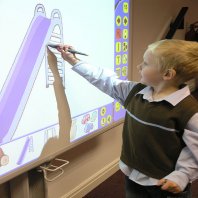 What are the barriers to “more use of edtech” in schools? A recent British Educational Suppliers Association (BESA) survey, as recently reported in the TES, suggested that budgets and “teachers’ unwillingness” were two of the main barriers identified by the survey. But was the right question being asked?
What are the barriers to “more use of edtech” in schools? A recent British Educational Suppliers Association (BESA) survey, as recently reported in the TES, suggested that budgets and “teachers’ unwillingness” were two of the main barriers identified by the survey. But was the right question being asked?
Firstly, looking at barriers to using “more” EdTech suggests that we don’t have enough and therefore should use more. This is a rather simplistic viewpoint as it suggests that the volume of EdTech in use is the key factor we should be seeking to address. In my view it isn’t. We should be seeking to use technology effectively and where appropriate. As Mike Sharples (@sharplm) recently commented, “technology alone will not transform education. Focus on pedagogy with new technology, not just the technology.”
The wide scale deployment of interactive whiteboards to schools can be considered as having increased the EdTech in education however I would challenge anyone to prove that it was effective. It didn’t improve outcomes. It didn’t support students in learning in new ways or improve their access to learning materials. It didn’t empower teachers to re-imagine the learning experience. In my view it simply allowed teachers to do what they always had been doing with a whiteboard/blackboard but using a digital surface instead, and at significant cost.
Taking the issue of budget into consideration, is it any wonder that school leaders would choose not to invest in EdTech where they can see limited added value from significant investment and where investment in other areas may show more reliable predictors of effectiveness or return on investment. If budgets were less strained maybe the situation would be different. As a result of this is it also therefore any small wonder that they would report that lack of budget as a reason for not investing, having themselves had to prioritise their spending.
Sticking with interactive whiteboards, the deployment of them was often to whole schools or departments. This approach to “more” is better fails to take into account different subject, teacher, student, topic, lesson, etc needs. It is a one shape fits all approach. What motivation does a teacher have to learn how best to use this new classroom technology given it has been foisted upon them. Teachers, due to not understanding the technology or having time to experiment, may also be unable to identify appropriate uses within their classroom and teaching for this new device. Given the lack of intrinsic motivation and perceived appropriateness of the technology is it any wonder that “teachers’ unwillingness” to make use of more EdTech might be perceived and reported by schools.
In looking at EdTech use in schools we need to adopt a more nuanced approach. It isn’t about using more Edtech. It should be about considering the different needs of teachers and students and allowing them to experiment and use solutions which fit these needs. From this, best practice can be identified and shared, and approaches can be regularly reviewed and revised to maximise their impact. I should note that an open, supportive culture and warm, friendly organisational climate is key to enabling this.
I also wonder about some teacher’s perception of what “good” use of EdTech looks like. Social media gives us plenty of examples of exemplary teaching using EdTech however this often comes from teachers who have got to this point from long periods of trial, error and practice which isn’t evident from social media postings. Also, the posts generally focus on the good, may be staged for marketing purposes for the school, or may be biased or divorced from the real world in other ways. EdTech doesn’t necessarily have to be a complex all singing and dancing affair or something worthy of a photo shoot and full page spread in an educational magazine. Good initial use of EdTech might be a simple and limited action relating to a specific part of a lesson. It could be simply to make use of an application such as Microsoft Teams or Showbie. From here it can built upon. Additionally, good use of EdTech seldom comes about without significant time, effort and experimentation. It is also worth noting that technology is always changing and new uses for existing technologies can always be found and therefore the seeking of improvement is never ending. This is a bit like teaching in general where there is always room to build upon practice with each new lesson, topic, class or academic year.
I think back to a presentation I gave in Dubai some years ago in which I identified what I believed at the time to be the factors I thought were key to Technology use in schools. Teacher motivation, confidence and training were some of the factors I listed and I continue to believe these are key although I think my view as to training is now broader than it was then. Training in my eyes now includes using social media, such as twitter, peer discussion and planning, experimenting and traditional training sessions. A key issue supporting these three factors is the culture and climate within a school. Open and supportive school cultures promote sharing of ideas and allow for trial and error to occur.
It is with this in mind I wonder whether a better question would have been: What are the barriers to supporting teachers to use Edtech in my school?

